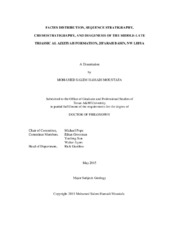| dc.description.abstract | This study presents the depositional facies, sequence stratigraphy, chemostratigraphy and diagenetic evolution of the Middle-Late Triassic Al Aziziyah Formation, Jifarah Basin northwest Libya. Eight measured sections were sampled and analyzed. High-resolution stable carbon isotope data were integrated with an outcrop-based sequence stratigraphic framework, to build the stratigraphic correlation, and to provide better age control of the Al Aziziyah Formation using thin section petrography, cathodoluminescence (CL) microscopy, stable isotope, and trace element analyses.
The Al Aziziyah Formation was deposited on a gently sloping carbonate ramp and consists of gray limestone, dolomite, and dolomitic limestone interbedded with rare shale. The Al Aziziyah Formation is predominantly a 2nd-order sequence (5-20 m.y. duration), with shallow marine sandstone and peritidal carbonate facies restricted to southernmost sections. Seven 3rd-order sequences were identified (S1-S7) within the type section. North of the Ghryan Dome section are three mainly subtidal sequences (S8-S10) that do not correlate to the south. Shallowing upward trends define 4th-5th order parasequences, but correlating these parasequences between sections is difficult due to unconformities.
The carbon isotope correlation between the Ghryan Dome and Kaf Bates sections indicates five units of δ13C depletion and enrichment (sequences 3-7). The enrichment of δ13C values in certain intervals most likely reflects local withdrawal of 12C from the ocean due to increased productivity, as indicated by the deposition of organic-rich sediment, and/or whole rock sediment composed of calcite admixed with aragonite. The depletion of δ13C is clearly associated with exposure surfaces and with shallow carbonate facies. Heavier δ18O values are related to evaporetic enrichment of 18O, whereas depletion of δ18O is related to diagenesis due to freshwater input.
Al Aziziyah Formation diagenetic events indicate: 1) initial meteoric and shallow burial; 2) three types of dolomite D1, D2 and D3 were most likely formed by microbial, seepage reflux and burial processes, respectively; and 3) diagenetic cements cannot be related to the arid, mega-monsoonal climate of the Triassic and most likely formed subsequently in a humid, meteoric setting. | en |


